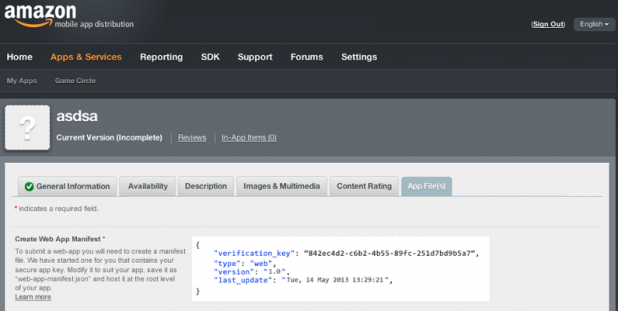 Amazon has opened up its Kindle Fire tablet to HTML5 Web apps. The online retailer’s newly released tools for HTML5 Web apps include a Web App Tester (complete with debugging tools and a production environment) and an Amazon In-App Purchasing API for JavaScript. Developers can build their apps with HTML5, CSS and JavaScript, smoothing out performance with Amazon’s GPU-accelerated Web app runtime. “Kindle Fire’s web runtime is based on the open source Chromium project, and is GPU-accelerated and optimized for fluidity to make sure your web apps run smooth on Kindle Fire, just like a native app,” reads a note on Amazon’s Mobile App Distribution Blog. “The new runtime supports the latest HTML5/web features and includes standards-based extensions that give you access to offline storage and location sensors.” The advantages for Amazon are pretty clear: by encouraging developers who build HTML5 Web apps to include an in-app purchasing option, Amazon gets a significant cut of the inevitable purchases. That means more revenue from expansion packs, upgrades, new gaming episodes, and pretty much anything else app-related. The addition of in-app purchasing for Web apps also puts Amazon’s app store on more equal footing with Google Play and Apple’s App Store. Amazon’s Web apps are available for the Kindle Fire and “select Android devices” in nearly 200 countries, including the United States, Japan, and big chunks of the E.U. Web apps may also encourage use of Amazon’s virtual currency. The retailer has restricted the use of its “Amazon Coins” to buying apps and games for the Kindle Fire, with one Amazon Coin worth one U.S. cent; in other words, it’s not a direct competitor to Bitcoin. But that could change, especially if Amazon decides to expand the Coins’ redeeming value past Kindle apps to physical goods. In the meantime, Amazon’s Web Resources Overview presents a number of tips for building a Web app, including setting up environments and security features. Image: Amazon
Amazon has opened up its Kindle Fire tablet to HTML5 Web apps. The online retailer’s newly released tools for HTML5 Web apps include a Web App Tester (complete with debugging tools and a production environment) and an Amazon In-App Purchasing API for JavaScript. Developers can build their apps with HTML5, CSS and JavaScript, smoothing out performance with Amazon’s GPU-accelerated Web app runtime. “Kindle Fire’s web runtime is based on the open source Chromium project, and is GPU-accelerated and optimized for fluidity to make sure your web apps run smooth on Kindle Fire, just like a native app,” reads a note on Amazon’s Mobile App Distribution Blog. “The new runtime supports the latest HTML5/web features and includes standards-based extensions that give you access to offline storage and location sensors.” The advantages for Amazon are pretty clear: by encouraging developers who build HTML5 Web apps to include an in-app purchasing option, Amazon gets a significant cut of the inevitable purchases. That means more revenue from expansion packs, upgrades, new gaming episodes, and pretty much anything else app-related. The addition of in-app purchasing for Web apps also puts Amazon’s app store on more equal footing with Google Play and Apple’s App Store. Amazon’s Web apps are available for the Kindle Fire and “select Android devices” in nearly 200 countries, including the United States, Japan, and big chunks of the E.U. Web apps may also encourage use of Amazon’s virtual currency. The retailer has restricted the use of its “Amazon Coins” to buying apps and games for the Kindle Fire, with one Amazon Coin worth one U.S. cent; in other words, it’s not a direct competitor to Bitcoin. But that could change, especially if Amazon decides to expand the Coins’ redeeming value past Kindle apps to physical goods. In the meantime, Amazon’s Web Resources Overview presents a number of tips for building a Web app, including setting up environments and security features. Image: Amazon Amazon Opens Kindle Fire to HTML5 Web Apps
 Amazon has opened up its Kindle Fire tablet to HTML5 Web apps. The online retailer’s newly released tools for HTML5 Web apps include a Web App Tester (complete with debugging tools and a production environment) and an Amazon In-App Purchasing API for JavaScript. Developers can build their apps with HTML5, CSS and JavaScript, smoothing out performance with Amazon’s GPU-accelerated Web app runtime. “Kindle Fire’s web runtime is based on the open source Chromium project, and is GPU-accelerated and optimized for fluidity to make sure your web apps run smooth on Kindle Fire, just like a native app,” reads a note on Amazon’s Mobile App Distribution Blog. “The new runtime supports the latest HTML5/web features and includes standards-based extensions that give you access to offline storage and location sensors.” The advantages for Amazon are pretty clear: by encouraging developers who build HTML5 Web apps to include an in-app purchasing option, Amazon gets a significant cut of the inevitable purchases. That means more revenue from expansion packs, upgrades, new gaming episodes, and pretty much anything else app-related. The addition of in-app purchasing for Web apps also puts Amazon’s app store on more equal footing with Google Play and Apple’s App Store. Amazon’s Web apps are available for the Kindle Fire and “select Android devices” in nearly 200 countries, including the United States, Japan, and big chunks of the E.U. Web apps may also encourage use of Amazon’s virtual currency. The retailer has restricted the use of its “Amazon Coins” to buying apps and games for the Kindle Fire, with one Amazon Coin worth one U.S. cent; in other words, it’s not a direct competitor to Bitcoin. But that could change, especially if Amazon decides to expand the Coins’ redeeming value past Kindle apps to physical goods. In the meantime, Amazon’s Web Resources Overview presents a number of tips for building a Web app, including setting up environments and security features. Image: Amazon
Amazon has opened up its Kindle Fire tablet to HTML5 Web apps. The online retailer’s newly released tools for HTML5 Web apps include a Web App Tester (complete with debugging tools and a production environment) and an Amazon In-App Purchasing API for JavaScript. Developers can build their apps with HTML5, CSS and JavaScript, smoothing out performance with Amazon’s GPU-accelerated Web app runtime. “Kindle Fire’s web runtime is based on the open source Chromium project, and is GPU-accelerated and optimized for fluidity to make sure your web apps run smooth on Kindle Fire, just like a native app,” reads a note on Amazon’s Mobile App Distribution Blog. “The new runtime supports the latest HTML5/web features and includes standards-based extensions that give you access to offline storage and location sensors.” The advantages for Amazon are pretty clear: by encouraging developers who build HTML5 Web apps to include an in-app purchasing option, Amazon gets a significant cut of the inevitable purchases. That means more revenue from expansion packs, upgrades, new gaming episodes, and pretty much anything else app-related. The addition of in-app purchasing for Web apps also puts Amazon’s app store on more equal footing with Google Play and Apple’s App Store. Amazon’s Web apps are available for the Kindle Fire and “select Android devices” in nearly 200 countries, including the United States, Japan, and big chunks of the E.U. Web apps may also encourage use of Amazon’s virtual currency. The retailer has restricted the use of its “Amazon Coins” to buying apps and games for the Kindle Fire, with one Amazon Coin worth one U.S. cent; in other words, it’s not a direct competitor to Bitcoin. But that could change, especially if Amazon decides to expand the Coins’ redeeming value past Kindle apps to physical goods. In the meantime, Amazon’s Web Resources Overview presents a number of tips for building a Web app, including setting up environments and security features. Image: Amazon 